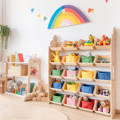Building a Montessori Play Area: Essential Toys for Every Age
In a world with a plethora of toys claiming to be educational, the idea of creating an enriching environment for your child seems a bit daunting. However, if you browse the Montessori toys by age, you’re off to a great start.
In that light, we’ll discuss the importance of creating a Montessori-inspired environment for your child. With a focus on age-appropriate toys, we’ll go over every option possible and provide you with a clear picture of what a Montessori environment should look like.

First, don’t just get any toys - create an environment that sparks their imagination, creativity, and meaningful play.
Setting Up a Montessori Play Area
Introducing the Montessori method to your child's play area is not just about the toy - it’s about every little detail, like how they feel while playing; whether they are learning or just having fun, they will want to play again in this kind of environment.
Therefore, focusing on independence, order, and the child’s natural desire to learn through play, the Montessori play area is a carefully designed space in which children are encouraged to explore and learn every day.
What Is A Montessori Playroom?

A Montessori playroom is a carefully designed space for children that follows the principles of the Montessori educational approach. It focuses on independence, order, and hands-on learning. This space usually features child-sized furniture, open-ended toys, and an organized layout to spark a child's natural curiosity and self-directed exploration.
The goal?
Truly educational - The goal is to create an environment where children can engage in activities that promote both cognitive and physical development.
How Do You Organize a Montessori Room?
Organizing a Montessori room requires careful consideration and a good look at your child. You should focus on activities that are meant for your child and adapt the room as the years go by.

Here’s a step-by-step guide on how to best organize a Montessori room from scratch:
1. Clear the clutter: Remove unnecessary items from the room to create a clean and open space for playing. It’s a good idea to keep only age-appropriate toys and materials that are going to be used.
2. Child-sized furniture: Get child-sized furniture to encourage independence in your little ones. Also, it’s important to arrange that furniture to allow for an open flow. For example, put the table at the center of the room, not near the wall.
3. Accessible shelves: Use low, open shelves to display toys and other learning stuff, making them easily accessible to the child.
4. Sort and rotate toys: Make a toy categorization based on their purpose. For example, put toys that are meant to develop fine motor skills in one box. Make sure to rotate toys to keep things fresh and maintain the child's interest.
5. Create activity zones: Make sure to create specific areas for different activities, such as reading, art, and practical life skills.
6. Promote independence: Place everyday items, like clothing or snacks, within the child's reach to encourage them to do things on their own.
7. Natural materials: Opt for toys and materials made from natural materials like wood or fabric in line with Montessori principles.
8. Minimize distractions: Keep decorations and wall art simple, avoiding overwhelming patterns or bright colors. Also, don’t install any electronic devices in the room; TVs and video games are not a part of the Montessori play area.
Following these steps will ensure you create a perfect fun zone where children can learn and explore as they play.
Toy Selection Guide for Different Age Groups
Selecting the right kind of toys mostly depends on your child’s age. However, it’s not a bad thing to equip the room with toys and materials that are meant for older stages of development.
This way, your child will progress and learn the way they’re supposed to.
But, the crucial thing to know when setting up the Montessori play area is to choose the right kind of toys. In that light, let’s take a look at the age-appropriate toys for each stage of development:
Babies 0-12 Months

When it comes to babies, you should look out for toys that are specially designed for reaching infant developmental milestones. As for the materials, these toys are usually made out of wood and fabric.
Here are a couple of categories and examples for each:
- Soft and textured toys: Soft toys are perfect for babies as they are still exploring the world with their hands. A good example of this kind of toy is the Montessori Baby Cloth Book.
- High-contract toys: By stimulating visual development, high-contract toys are very important in the early stages of cognitive development for babies. One good example is the Montessori Newborn Contrast Book.
- Simple-grasping toys: These toys are crucial for the development of fine motor skills. Babies are learning how to hold, grasp, and pull things. A solid example of this toy is the Montessori Silicone Pulling Toy, which allows your child to practice grasping and pulling at the same time.
Toddlers 1-3 Years

Toddlers are easily entertained with choices; therefore, make sure to provide your toddler with open-ended toys as they can positively affect their development. At this stage, they are a bundle of joy and excitement, and the only way to channel all that energy into productive learning through play is in a Montessori-inspired environment.
In that light, equipping a room with toys appropriate for toddlers is usually fun for both the parent and the child. Here’s a couple of great examples:
- Building toys: Anything that requires your child to stack, build, or rearrange is a good toy for developing fine motor skills and creativity. The goal here is to allow them to express themselves through play, and toys like the Montessori Building Blocks are the perfect choice.
- Shape sorting and puzzles: As for the cognitive development of toddlers, toys like puzzles or shape sorters are the best option. Even though these aren’t open-ended examples, they still spark creativity in their own way. Going for a good wooden puzzle or a Montessori Penguin's Clock 2.0 will ensure a productive playtime for your little one.
- Art supplies: Art activities are a great way for children to express themselves on paper. Plus, they’ll practice fine motor skills as well. In your Montessori play area, feel free to include art supplies like crayons, non-toxic paint, and large papers.
Preschoolers 3-6 years

When it comes to preschoolers, the Montessori play is focused on open-ended toys that spark creativity and imagination. Also, ensuring your child at this age is equipped with toys to practice real-life skills is crucial for their development.
Some good examples:
- Open-ended toys: Preschoolers create the world around them through play, which is why they need toys like dolls, building blocks, or anything with an open-ended nature. One good example is the Montessori Magnetic Set, which allows your child to create shapes and objects, sparking their imagination.
- Montessori practical toys: Practical toys are great at this stage of development as they teach our children something from real life. One good example is the Montessori Wooden ToolBox. This toy allows your kid to play for hours and explore how to create different fun models.
- Nature-inspired toys: Nature-inspired toys allow your child to learn about how the world works around them. For example, preparing their favorite meals with the Montessori Cooking Tools.
Rotating Toys and Toy Storage
After creating a fun Montessori play area for your child, it’s important to maintain everything the right way. That’s why we’ll discuss a couple of things that every parent should do.

Organizing Toys and Storage
When it comes to organizing toys, there are a couple of ways to do so. The most important thing to remember here is that your child should have easy access to their toys.
1. Use labeled containers: Labeling toy containers or boxes is a great way of keeping everything in order. Namely, get a couple of boxes or wooden containers to sort toys and keep them organized easily.
2. Install accessible shelves: Feel free to arrange toys on accessible shelves. This will promote independence and encourage children to choose their activities.
3. Designate areas for special toys: Designate specific areas for different types of toys, fostering organization and order within the play area.
Importance of Toy Rotation
Toy rotation is a great way to keep things fresh for your child so they don’t get bored playing with only a couple of their ‘’favorite’’ toys. Some of the benefits that come from rotating toys often:
1. Your child will always be interested in playing with new toys.
2. By rotating and constantly introducing new toys, your child will be stimulated to explore more out of curiosity.
3. A special selection of toys enhances focus, allowing children to dive deeper into specific activities.
Promote Tidying Up

Equally important as organizing and rotating toys is showing your child how to tidy up. It will create a sense of independence and responsibility. Teaching them to clear behind them is an important life skill.
Therefore, make sure to instill the habit of tidying up after play by making it a part of the daily routine. Playing in a messy environment can make children overwhelmed with choices - this is the true importance of a simple environment for play.
Conclusion:
By implementing the Montessori method in your child’s play area, you’ll create a room where exploration and curiosity arise. The overall organization, thoughtful toy selection, and the practice of rotating toys shape the environment that adapts to the child's growing curiosity.
In this kind of space, your child will feel safe and ready to learn through play, as each toy represents a tool for development.
Free Delivery
Over $80
Easy Returns
No questions asked
Unbeatable Warranty
1-year ++ warranty
- Secure CheckoutWorld’s most secure payment method





